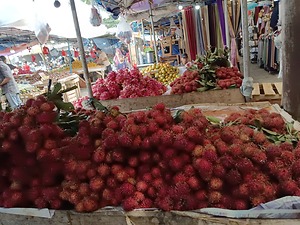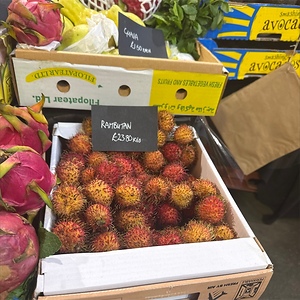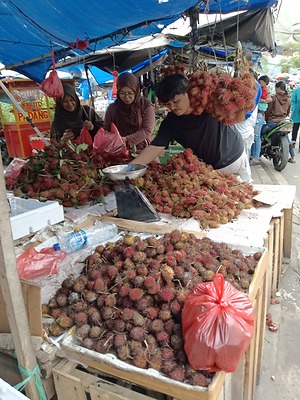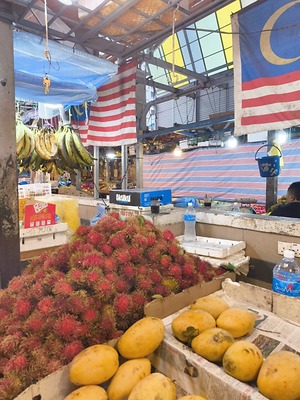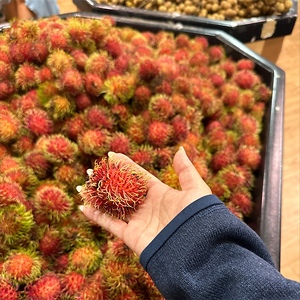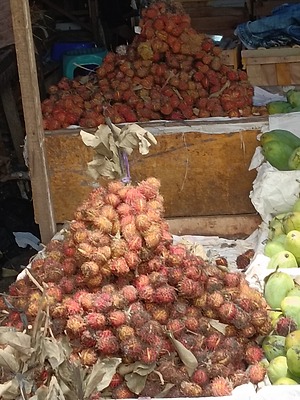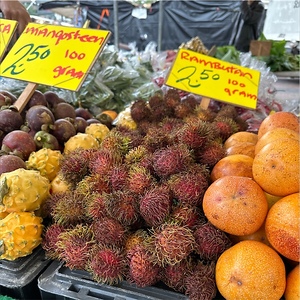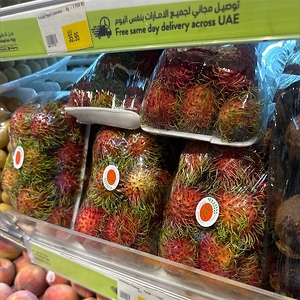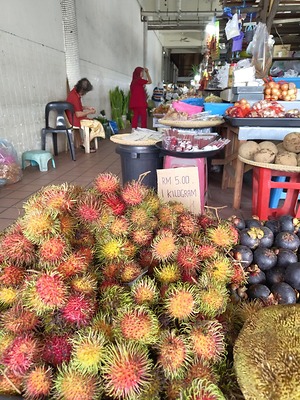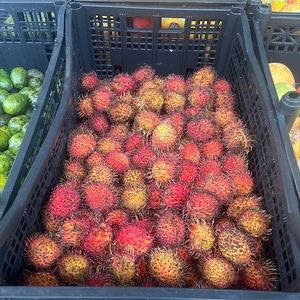

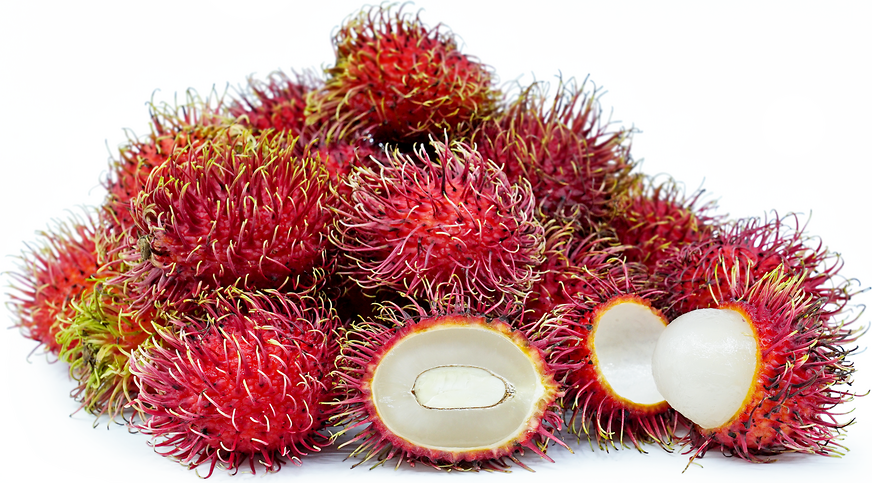
Rambutan
Estimated Inventory, 5 lbs : 0.39
This item was last sold on : 07/01/25
Description/Taste
Rambutans are small, oval to round fruits, averaging 3 to 5 centimeters in diameter, and grow in loose, hanging clusters of 10 to 20 fruits. There are many different varieties of Rambutan with unique appearances, ranging in color from red, orange, yellow to a blend of these hues. The fruits are enveloped in a semi-thick, firm, and leathery rind, covered in soft, spine-like protrusions known as spinterns. Underneath the rind, the flesh varies from white, translucent, to pale pink and is succulent and slightly chewy, encasing a central, oblong, light brown seed wrapped in thin, papery layers. Rambutans are aromatic and have a sweet, fruity flavor with mild acidity, containing subtle notes of strawberries and grapes.
Seasons/Availability
Rambutans are available seasonally, depending on the region, and are generally found in the fall and winter. In tropical areas of Southeast Asia, the trees fruit twice a year, while trees in Central America tend to only fruit for a single season.
Current Facts
Rambutans, botanically classified as Nephelium lappaceum, are exotic fruits with an unusual appearance found on evergreen trees belonging to the Sapindaceae family. The tropical fruits are a part of the same family as the lychee and are native to Southeast Asia, primarily consumed fresh, out-of-hand. There are over 200 varieties of Rambutans with varying colors, flavors, and appearances. The name Rambutan is derived from the Malaysian word “rambut,” translating to mean “hair,” and is a descriptor given for the fruit’s hairy, spine-like appearance. Rambutan cultivation is increasing worldwide as the fruits are valued for fresh eating, desserts, and flavoring beverages. The trees are prolific and can produce hundreds of fruits in a season. Rambutans are easily bruised and must be harvested by hand, cut in clusters to prevent the rind's tearing. Rambutans also have a short shelf life, limiting the fruit’s ability to be exported long distances. Beyond the fruits, Rambutan trees are considered an ornamental variety, valued for their color contrast between the bright fruits and dark green leaves.
Nutritional Value
Rambutans are a good source of copper to help maintain bones and nerves and provide vitamin C, an antioxidant that strengthens the immune system and reduces inflammation. The fruits also contain fiber to regulate the digestive tract and contribute smaller amounts of iron, phosphorus, manganese, and magnesium.
Applications
Rambutans are best suited for fresh applications as their sweet flavor is showcased when consumed straight, out-of-hand. The rind can be sliced and opened with a knife or peeled by hand, and the flesh can be consumed raw, discarding the seed. The seed is edible, but it needs to be cooked before eating. The flesh can be sliced and mixed into fruit salads, used as a topping over sorbet and ice cream, or incorporated into curries and soups for added sweetness. The fruits can also be muddled into cocktails, simmered into a simple syrup, or cooked into jellies and jams. In addition to fresh preparations, Rambutan can be stewed or canned for extended use. Rambutan pairs well with other fruits such as coconut, pineapple, kiwi, and mango, aromatics including ginger, lemongrass, turmeric, and mint, honey, and meats such as poultry, fish, and beef. Whole Rambutans will keep for 2 to 3 days when wrapped in a damp paper towel and stored in a ventilated bag in the refrigerator. The fruits are prone to drying out and should be consumed immediately for the best quality and flavor.
Ethnic/Cultural Info
Thailand is the largest producer of Rambutan, accounting for over half of the world’s supply, and cultivates the fruits for the fresh market and canning industry. Rambutans were first planted in Thailand in Ban Na San, a district within the Surat Thani province, in 1926 through a man named K. Vong. The fruiting trees were popular for their ornamental appeal and prolific fruit production, and over time, Rambutans became one of the province's top agricultural products. Rambutan production is also used to support increasing agritourism. To commemorate and celebrate the tropical fruit's economic impact, an annual Rambutan fair is held in the fall to attract residents and tourists. During the fair, farm tours, contests, beauty pageants, and parades are centered around the tropical fruit and marathons, cycling, and other athletic competitions are also held. One unique event of the Rambutan fair is a monkey agility demonstration. Surat Thani is known for its trained monkeys, who are primarily used scale palm trees to collect coconuts, and the primates are taught at a famous monkey school within the province.
Geography/History
Rambutans are native to Indonesia and Malaysia and have been growing wild since ancient times. Between the 13th and 15th centuries, experts believe Arab traders encountered the fruits through trade routes and introduced Rambutan into the Tanzanian archipelago of Zanzibar, located off the coast of East Africa. The fruits were also spread throughout Southeast Asia, Oceania, and were later brought to South America in the 19th century. In the modern-day, Rambutan can be found worldwide, including tropical regions of Asia, Southeast Asia, Australia, Africa, Central America, the Caribbean, South America, and Hawaii of the United States. The fruits are primarily cultivated in Indonesia, Thailand, and Malaysia, but they are also increasing in cultivation in Central America for export into the United States.
Featured Restaurants
Restaurants currently purchasing this product as an ingredient for their menu.
| Marine Group Global Services LLC | San Diego CA | 619-972-9345 |
| C 2 C | San Diego CA | 619-972-9345 |
Recipe Ideas
Recipes that include Rambutan. One



